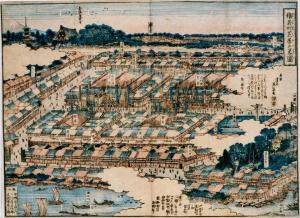Sketch of the Plays in Saruwaka Town (Saruwakamachi Shibai no Ryakuzu)
Painted by Keisai Eisen Around 1842 (Tempō 13) Tokyo Shiryō Collection 575-C14
This is a bird's eye view of the entire Saruwaka Town, which helps us to gain a good understanding of the atmosphere of this so-called theater town. By order of the Shogun, the Nakamuraza and Ichimuraza Theaters moved in 1842 (Tempō 13) and the Kawarazakiza Theater, which is a hikae-yagura (the alternate theater which was allowed to give a performance when three officially recognized Kabuki theaters of Edo were not available) of the Morita Theater moved in the following year into Saruwaka Town, making it one of the largest theater towns.
Saruwaka town (near Asakusa 6-chome in Taitō ward) was a closed area which was accessible only through the wooden gates installed at the south, north and southeast of the town. In addition to the theaters, there were teahouses attached to a theater, houses for actors and theater-related people, restaurants, souvenir shops, stage set stores, and theater properties shops in Saruwaka town. The Shogunate incorporated all the people and properties related to theaters into this town.
The town name used to be Asakusa Seiten town, but changed to Saruwaka town when Nakamura Kanzaburō (Saruwaka) I, the founder of Edo Kabuki, opened the Saruwakaza Theater in this town in 1624 (Kan-ei 1). Saruwaka town had from 1-chome to 3-chome with the Nakamuraza Theater in 1-chome; the Ichimuraza Theater in 2-chome; and the Moritaza Theater in 3-chome. In the Meiji period, however, the Moritaza Theater moved to Shintomi-cho (in Chuo ward) and the other two theaters also relocated to Torigoe-cho and Shitaya Nicho-cho (both in Taito ward) respectively. The role of Saruwaka Town as a theater town came to an end after all the rest of the theaters moved to the central area of the city in 1892 (Meiji 25).
This picture is presumed to have been published in 1842 (Tenpō 13) because the 3-chome area, to which the Kawarazaki Theater was scheduled to move, is hidden behind the clouds.


